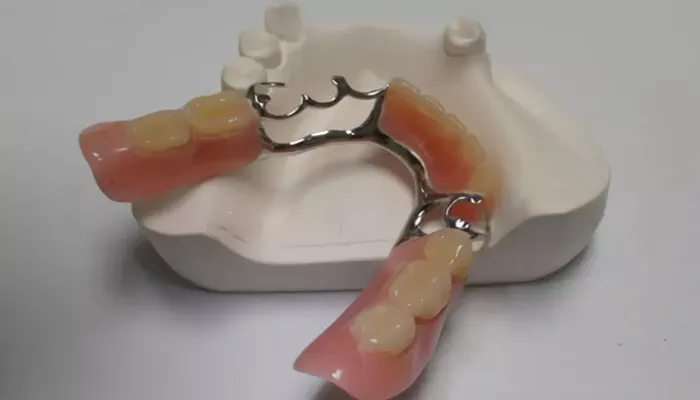Elastic partial dentures, also known as invisible partial dentures, represent a significant advancement in dental prosthodontics. These dentures are crafted from high-elastic, strong, and non-toxic polymers, designed to replace the metal clasps and bases found in traditional dentures. The primary objectives of this design are to enhance aesthetic appeal and wearing comfort. Below, we will delve into the specifics of elastic partial dentures, exploring their characteristics, advantages, disadvantages, and what constitutes the best option from a professional dental perspective.
Characteristics of Elastic Partial Dentures
Materials: Elastic partial dentures primarily utilize materials such as pure titanium and common resins. High-quality silicone materials are also commonly used due to their excellent elasticity and transparency. These materials allow the dentures to better integrate with oral tissues.
Design: The base of elastic partial dentures is thin and compact, providing a snug fit with minimal extension. This design ensures optimal retention without causing discomfort. Additionally, the elastic materials maintain their shape and volume stability in moist environments, contributing to enhanced comfort.
Advantages of Elastic Partial Dentures
Aesthetic Appeal
The most prominent advantage of elastic partial dentures is their aesthetic quality. Unlike traditional dentures, which often have visible metal clasps, elastic partial dentures do not use metal clasps on the abutment teeth. Instead, the base color of the denture closely resembles the gingiva, appearing translucent and blending seamlessly with the gums under oral moisture, making it difficult to distinguish from natural teeth. This high degree of realism greatly enhances the aesthetic appeal.
Comfort
The thin and compact base of elastic partial dentures ensures a snug fit, reducing the sensation of a foreign object in the mouth. The elastic material’s excellent resilience and shape stability in wet environments provide a comfortable wearing experience with minimal or no discomfort.
Durability
The elastic materials used in these dentures exhibit good toughness and bending strength. Clinical tests have shown no signs of cracking or breaking. Even when dropped and stepped on, the dentures retain their shape and function as new.
Protection for Oral Tissues
Elastic partial dentures primarily rely on mucosal support, with a few being mixed support types. The retention elements are designed on the necks of the teeth and the alveolar ridge below, with the abutment teeth and alveolar ridge sharing the occlusal force. The elasticity and toughness of the dentures cushion the chewing pressure in the edentulous area, protecting the abutment teeth and surrounding tissues. Additionally, the intermittent chewing pressure provides physiological massage to the gingiva and alveolar ridge, promoting tissue health.
Simplicity of Fabrication
Elastic partial dentures can be produced through a single injection molding process without the need for heat treatment, saving time and effort.
Non-Allergenic
The materials used in making elastic partial dentures do not contain monomers, which irritate tissues and cause allergic reactions.
Disadvantages of Elastic Partial Dentures
Deformation and Damage
Due to their soft material, elastic partial dentures are prone to deformation under occlusal forces, leading to increased instability. Additionally, their wear resistance is relatively poor, and they may sustain damage or wear over time, requiring regular maintenance and replacement.
Limited Indications
Elastic partial dentures may not be suitable for all patients. Their soft material and design make them less stable compared to traditional dentures, which rely on metal clasps for retention. Therefore, they are best suited for patients with mild to moderate tooth loss and good oral health.
Selection Criteria for the Best Elastic Partial Denture
When determining the best elastic partial denture, several factors should be considered, including material quality, design, fit, and the patient’s specific oral condition and needs.
Material Quality
High-quality materials are crucial for the durability and comfort of elastic partial dentures. Pure titanium and high-quality silicone materials offer excellent elasticity, transparency, and biocompatibility, making them ideal choices.
Design
A well-designed elastic partial denture should provide a snug fit, minimize discomfort, and enhance aesthetic appeal. The base should be thin and compact, with retention elements strategically placed to ensure stability without compromising comfort.
Fit
The fit of the elastic partial denture is essential for its function and comfort. A poorly fitting denture may cause discomfort, instability, and even damage to surrounding tissues. Therefore, it is crucial to ensure that the denture fits snugly and comfortably in the patient’s mouth.
Patient-Specific Factors
The selection of the best elastic partial denture should also consider the patient’s specific oral condition and needs. For example, patients with mild to moderate tooth loss and good oral health may benefit from elastic partial dentures, while those with severe tooth loss or poor oral health may require alternative treatment options.
Comparison with Other Dental Prostheses
Traditional Partial Dentures
Traditional partial dentures use metal clasps and bases, which may be visible and less aesthetically pleasing. They are also relatively bulky and may cause discomfort. However, they offer good stability and durability, making them suitable for patients with severe tooth loss.
Implant-Supported Dentures
Implant-supported dentures provide excellent stability and comfort, as they are anchored to dental implants in the jawbone. However, they require surgical implantation and may be more expensive and invasive than elastic partial dentures.
Fixed Bridges
Fixed bridges are permanent dental prostheses that replace one or more missing teeth. They are supported by adjacent teeth or dental implants and offer excellent stability and aesthetic appeal. However, they may require the reduction of adjacent teeth for placement and may not be suitable for patients with poor oral health.
Conclusion
Elastic partial dentures represent a significant advancement in dental prosthodontics, offering patients a more aesthetically pleasing and comfortable alternative to traditional dentures. Their high-elastic materials and innovative design provide excellent fit, stability, and comfort while enhancing the aesthetic appeal of the smile. However, it is crucial to consider the patient’s specific oral condition and needs when selecting the best elastic partial denture. Factors such as material quality, design, fit, and patient-specific factors should be taken into account to ensure that the patient receives the most appropriate and effective treatment option.
Related topics:

